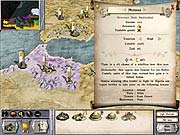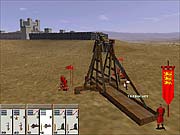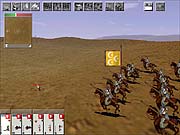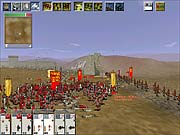Medieval: Total War, like its predecessor, Shogun, is both a turn-based strategy game and a real-time tactical combat game featuring massive armies containing hundreds or even thousands of troops. Released in 2000, Shogun might not have pioneered this style of gaming, but it was definitely one of the best strategy games to come around in a while. Now, two years later, developer Creative Assembly has returned with a follow-up set in the Middle Ages of Europe. It's another outstanding strategy game that's highly complex but richly rewarding.

Like feudal Japan, Europe in the Middle Ages was rife with political intrigue and open warfare. However, because of the more diverse range of peoples and histories, Europe and the surrounding areas of the Middle East and Mediterranean were prone to even more vehement hostility. Add to this fire the historic influence of the Church and the major role of religion in the development of the Middle Ages and you have a powder keg of possibilities that is more exciting even than the Senroku Jidai period depicted in Shogun. In Medieval, there is a lot more going on, and the game reflects that, providing a richer experience than the first Total War game.
Those unfamiliar with the Total War series will find a rewarding and very complex experience awaiting them in Medieval. Those who played Shogun would undoubtedly expect no less. Either way, you'll definitely need to play the tutorial before getting started in earnest, as the game at first seems overwhelming. There is a turn-based strategic portion to the game that plays like Risk, where you manage your empire and resources while marshaling your armies for eventual battle with your neighbors. In this mode, you see Europe as a 2D map and move various game pieces representing your emissaries, spies, and armies across brightly colored provinces and empires. And while you build units and construct buildings, you'll need to carefully watch your province's loyalty, maintain relations with neighboring empires, and nurture your economy. You'll also expand your empire by moving units to adjacent territories, increasing your holdings but also increasing the amount of necessary empire management. Any time your army pieces meet an enemy army piece in a contested province, the game switches to its real-time tactical mode. Here, the battle is played out in full 3D, as you control the actual armies on the battlefield. Medieval features literally a hundred different types of units, encompassing such things as artillery, including mangonels and cannons; foot archers; horse archers; infantry, such as halberdiers and spearmen; cavalry; conscripted peasants; gunpowder units; and much more.
In Shogun, the two halves of turn-based and real-time gameplay were playable and enjoyable, but the tactical portion was definitely the highlight--the strategic portion of the game was much less refined and developed. In Medieval, the designers have paid a lot more attention to delivering a more complete experience, and you won't feel like the quality in one portion was sacrificed for the other.
The strategic portion now has a lot more options, mainly because there are now 12 different factions to play, each with a few unique units and different strengths and weaknesses. In addition, there are now more buildings to construct and a lot more units overall, increasing the number of strategic possibilities for developing your provinces and armies. The game's setting lends itself to a lot more political intrigue than Shogun, and in addition to forging alliances through diplomacy, you can also marry off your daughters to create lasting ties with rival rulers. During the actual 400-year period covered in Medieval, religion played an enormous role in shaping history, and so it is in the game. Many of the different factions are aligned by religion--such as Catholicism and Islam--as are many of the provinces you can control. Matching your faction's religion with the religion of conquered provinces is a tricky business in Medieval, as Muslim provinces are more apt to rebel against Christian rulers, and vice versa. You'll have to monitor the zeal rating of your provinces, which measures how religious the province is and thus how much you'll need to appease the local populace with tax breaks or by appointing a general with the same religion to rule the region in your name.
Since the game is played in the Middle Ages, where lords often gave titles to their loyal generals, you can likewise gift land and titles to your loyal servants, who will then in turn govern the province in your name. You can actually use this system to your advantage, for example by making a pious Muslim general the leader of a Muslim province to increase its loyalty or by turning over control of a mineral-rich province to a shrewd general to increase revenues. Of course, if you do this, you have to give careful consideration to your general's loyalty (you don't want him to take the province away from you), his piety, his dread (which indicates whether he can cow the populace into submission), and his acumen (which determines how good of a money manager he is: The better he is, the more revenue he will generate for you).

You can begin the game without understanding all its nuances and complexity, but if you do, the computer or a smarter human opponent will tear you apart. There are so many subtle factors that govern how things work in Medieval that to ignore them is to invite disaster. In battle, for example, you can just march your army toward the enemy because you'll get there faster and engage quicker, but you might not realize that if you do so too early, your soldiers will be fatigued faster. In the strategy portion, you might just start gifting land to your generals right and left because you know doing so will make them happy. But if you don't realize how a low dread rating can lead to more open revolts, you could lose those territories you cede to incompetent generals.
One problem with the enhanced strategy portion of the game is the lack of information. Once your empire gets truly gigantic, you'll have a tough time keeping track of all the goings-on in your provinces. The current information lists are much too minimal. A more informative interface and easy access to listed information that could be sorted by different attributes (such as organizing generals by highest dread, piety, or acumen ratings or showing the unit and building queues for all provinces) would have made the game much easier to handle. Currently, the massive amounts of information to digest will strain the brains of even the most hard-core wargamers. Still, the strategy portion of the game is very rewarding to play, even if it's a bit too complex for some, and many fans of Risk and Civilization will simply want to play this mode alone.
As was the case in Shogun, though, the sexy draw of this game is still the epic real-time battles. In this regard, Medieval is at first glance surprisingly similar to the previous game. Small, pixelated 2D units can be seen rummaging around simple rolling 3D terrain. There's a good view distance and some weather effects, but not many frills. You might expect more from the game visually, considering it spent two years in development and especially considering how the genre has seen its share of visually stunning games lately, such as Battle Realms and Warcraft III. After all this time, the engine should have been completely rewritten to take advantage of current technology, or even the video cards of last year. Instead, Creative Assembly opted to use the same engine, albeit with a few enhancements, and the overall visual effect is underwhelming as a result. Yet, as you play the game, you'll find the same gratifying experience of massive hordes of fighters and realistic warfare. In this regard, Medieval still delivers.

While many recent real-time strategy games focus on smaller-scale battles between powerful units, Medieval goes in the opposite direction and promotes huge battles and gritty realism. In Medieval, you can command thousands of men. In fact, you can have up to 10,000 soldiers duking it out at a time. It's actually amazing to see that many troops onscreen at once, but this feat also accounts for the intermittent sluggish performance. When you do have 10,000 soldiers running around at once, the game starts to crawl, even on a high-end machine with plenty of RAM. If your system is slower, you'll need to turn off all sorts of visual features to get the game to run smoothly.
Medieval is a very realistic game that models real-world battlefield considerations like fatigue, ammunition, facing, and morale, elements that are usually omitted in other strategy games. It's a welcome change for those gamers who yearn for something more substantial. In Medieval, it pays to apply logic and forethought to your battle plans. Those who manage these subtle aspects of warfare with skill and intelligence will win many times more than those who don't. This also means gamers used to Command & Conquer and Warcraft will have to work their brains a little harder and put up with less instant gratification. That's because things don't happen instantaneously in Medieval. Most of the strategizing and thinking--most of the action--is done before any fighting actually takes place. In fact, most of your mental effort is spent on determining what sorts of troops to bring to battle in the first place, where to position your troops in regard to each other, scouting out the area to determine how best to use high ground and terrain to your advantage, and then maneuvering your men to battle without pushing them too hard or wearing down their morale.
Often, once battle is joined, it's much harder to maneuver and regroup than in other games. If your planning and setup aren't good enough to win the battle at first engagement, it takes supreme leadership and tactics to regain your advantage. Moving away from enemy units to reposition yourself often leaves your flanks exposed, which in Medieval's realistic warfare results in disaster. Thus, if you want to secure advantageous terrain and positioning, you often want to do it before you engage the enemy. You don't micromanage your units in Medieval as much as you do in other games, and even when you do, orders aren't carried out right away when you issue them. This will undoubtedly frustrate gamers used to immediate response from units in other games.
The most annoying aspect of the battles, though, is that they get very confusing very quickly, as armies in combat tend to devolve into messy blobs of mismatched color. The problem is compounded because the battles get so big that you need to zoom out to get a good view of all your forces. But when you do that, it becomes very hard to see the different unit groups. While you can click on a unit group's tab at the bottom of the screen to select it, if you have multiple unit groups of the same type, you won't know which one you clicked on. That's because although the unit group's banner will bounce up and down if selected, you'll be so far away that this effect will be almost unnoticeable. The inability to clearly discern units at far distances is definitely a problem, especially when battles get really big and with lots of different units. You will eventually have to use the camera a lot, and while it is fairly intuitive, it adds another level of complexity that could turn into a headache for some gamers.

Get used to it, and you'll find that Medieval offers great lasting value. The campaign game is open-ended, so you can play through in any number of ways and with infinite outcomes, especially considering the dozen playable factions and the challenging artificial intelligence. The historical campaigns, where you can replay events like the Hundred Years' War or King Richard Lionheart's Crusade, as well as the inclusion of a map editor, also add still more to the replay value.
Ultimately, Medieval is a very enjoyable game, but it isn't well suited for the casual gamer. The real-time tactical gameplay is light on spectacular unit abilities and heavy on realism, which might be too detail-oriented for some. Those who did not like Shogun's real-time battles won't like Medieval, although those wishing for more meat in the strategic portion will be pleased with this game's enhanced strategy element. Medieval has a lot of deep gameplay, but what's great is that you control how much of the complexity you digest. If you just want the strategic gameplay, you can always opt to let the computer automatically resolve battles so you don't have to control the real-time combat. If you just want to command armies and play out Braveheart-scale skirmishes, you can just jump into quick battles or play the campaign mode but have the computer manage many of the details. If you don't want to learn or master all the game's intricacies, you don't have to. The game will still be rewarding, although you might start wondering why you keep losing fights and provinces. Best of all, if you do want to master the game, there is a lot to learn, and as you play the game over and over again, you will find new ways to better manage your empire and better command your armies. Medieval: Total War achieves that rare quality of having something for nearly all strategy gamers, and most will find a lot to like in it, for a very long time.